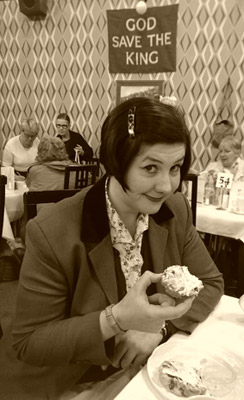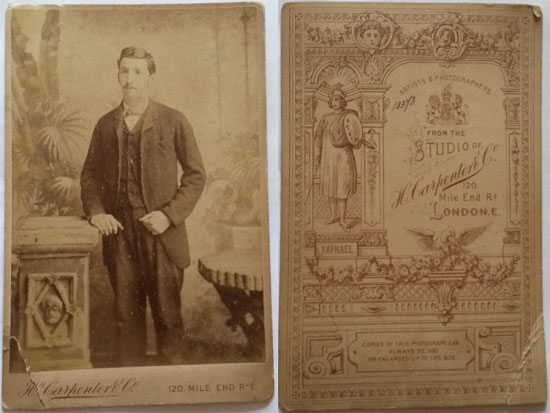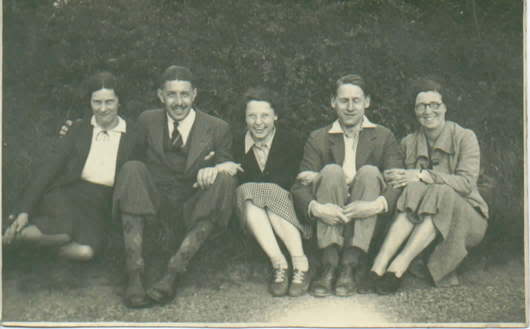I’d never been to WDYTYA? Live before, and wasn’t entirely sure what to expect. Everyone speaks about it in excitable tones, and now that it’s held in Birmingham at the NEC, rather close to where I live, it would be rude if I didn’t go.
It was so interesting speaking to people involved in genealogy in different ways. I really learnt a lot, and by the end of the day was exhausted from wandering about from stall to stall, and absorbing lots of new information. I was, however, pepped up by an enormous scone (slathered in clotted cream and Essex’s finest Tiptree jam!) at the 1939 tearooms, which was most welcome.

Meeting a photo expert
I took a couple of family photos with me. First, the group photo of the Ashworths, which I’ve tried to date before. I didn’t give the dating expert any info, and he went for 1908-1910. When I explained that I thought it was 1910, he agreed with me. Hurrah! It’s nice to know I was on the right track. He said he went on the women’s fashions. I asked him about the mysteriously large wristwatch that one of the women is wearing – he explained that it was a large leather watchstrap, which would have a fob watch set inside it. I had no idea, but that made so much sense and I feel I’ve learnt something.
I also took along a cabinet photo of my great-grandfather, John Henry Nunn.

The expert first of all laughed and pointed out that Mile End Road was “Jack the Ripper territory.” Then he said it was an impressive card (the back is certainly very nice) and is an example of one of the last cabinet photos – probably taken around 1905. He pointed out – and I hadn’t noticed this – that John’s watchchain is in fact woven hair. Not uncommon if you couldn’t afford gold, and was probably his wife’s. Given that he married my great-grandmother in 1901, it’s possible that this was taken at the time of their engagement, and that the chain was woven from her hair.
The Methodists
Still in the realms of the Nunns of East London, I spoke to the Methodists. Initially, this was to ask about John Wesley’s letters – according to my grandad, John Henry Nunn’s family had come from Suffolk and were “staunch Methodists” – there had been a letter from John Wesley in the family Bible that my great-grandmother had managed to lose when she moved house in the 1950s (along with a family tree that went back into the 1700s…). I thought that perhaps if I could find a mention of anyone called Nunn in Essex or Suffolk in Wesley’s papers, it might point me in the right direction to find John Henry’s ancestors (his grandfather, David Nunn, is a brickwall. He lived in Shoreditch but died in 1841 and I have no idea where he came from, other than my grandad’s recollection that he was from Suffolk). So I have some contact details now of people who might be able to help me look through Wesley’s correspondence.
In speaking to them, they told me that they’ve got websites where people can upload photos etc. relating to people involved in Methodism. The three sites are My Wesleyan Methodists, My Primitive Methodists and My Methodist History. They’ve put together a really helpful book which is vital for anyone who has Methodists in their family, which, apart from other things, explains why they need those three websites (after Wesley’s death, the Methodists split off from each other and it was only in the 1930s when most of them came back together again to be known as Methodists). I’ve uploaded a photo of Hackney Wick Wesleyan choir, which John Henry Nunn was the choirmaster of, and also a photo of my grandad on a Sunday School outing (wearing plus-fours, no less – well, it was the 1930s…).

Their book, A Methodist in the Family? by Philip Thornborow is excellent. Everything clearly explained, and it’s clarified some points in my mind. David Nunn was born in about 1786, and I assumed that as I’d searched the non-conformist registers online without any luck, I’d never find him. But until Wesley’s death in 1791, the Methodists considered themselves to be Anglicans, which means that David’s baptism is probably in an Anglican register… somewhere. This has given me hope, though!
Rebecca Probert – marriage law genius
Professor Probert of Warwick Uni has written two books on marriage for genealogists: Marriage Law for Genealogists and Divorced, Bigamist, Bereaved?. I’ve only had time since yesterday to start reading one of them (Rebecca had her own stall at the show), but I’ve learnt loads from just a few chapters and I really enjoyed how she gleefully ploughed her rhetorical bulldozer through all the myths you’ve ever heard about historical marriage. Don’t believe anyone who claims that people got married by jumping over a broomstick, or that “a lot of people didn’t get married before 1753”. All total hogwash, if you read Rebecca’s book. I have to say, I was glad she shared my doubts about those claims, too. Just because you can’t find a marriage where you expect it to be, doesn’t mean it never happened – you just haven’t looked in the right place.
I’ve had several lightbulb moments reading it – a non-Quaker marrying a Quaker couldn’t have a Quaker ceremony, a non-Jew marrying a Jew couldn’t have a Jewish ceremony (from what my grandad said, David Nunn’s mother was Jewish, but his father wasn’t, so his parents must have been married in an Anglican church. Again… somewhere….!) Given that two of the women in Poison Panic were accused of murdering their husbands, Rebecca’s research on how people ended marriages is really helpful for providing extra context.
I really do urge you to get hold of Rebecca’s books if you can – they’re really helpful, and written with great lucidity. I think I might be Prof. Probert’s fangirl, and, as she encourages submissions from genealogists, I have sent her info on the bigamist in my family (every tree should have one).
Deceased Online
I had a chat with the chap who runs Deceased Online. They’re making local authority cemetery records more easily available – digitising and transcribing. I was having a word about Essex cemetery records… we shall see. It’s definitely worth checking out their coverage info because they’ve got some enormous data sets which may well cover your research areas – for instance, they’ve just added 150,000 burial records for Sandwell in the Black Country, nearly half a million for Nottingham, and a quarter of a million for Aberdeenshire.
Suffolk Family History Society
I had a lengthy conversation with Arthur Bird who co-ordinates transcriptions of parish registers for Suffolk. He also has a brilliant south-east Suffolk accent! My transcriptions which fill gaps where they haven’t transcribed yet might end up as part of SFHS‘s collection. It’s really good for different groups to collaborate in this way, to prevent duplication of effort. While I was at it, I bought the second issue of the Suffolk burials CD – it has nearly 2 million records on it!
Jewish Genealogical Society of Great Britain
I spoke to Jeanette about my woes searching for David Nunn’s parents. It was really encouraging speaking to her – I explained how people in the past had said it was unlikely David’s mother could have been a Jew marrying a Suffolk farmer, but Jeanette said you can’t discount it because Jews were in many places, even in small numbers. And of course, we know there was a sizable Jewish community in Ipswich in the 1700s and 1800s – it’s not impossible that a Suffolk farmer could have married a Jew. She suggested DNA testing, which I’ve already done, but she suggested ways I could take the results forward – we’ll have to see.
The 1939 Tearoom
Whoever it is who works at Find My Past and thought that a good way to promote their forthcoming 1939 register was to have a 1930s tearoom is an utter genius. The wallpaper looked pretty accurate, the chairs looked like ones at the Rennie Mackintosh-designed Willow Tearooms in Glasgow, the waiter and waitresses were all in correct costume, and there was a lady in proper 1940s gear answering any questions people might have about the 1939 register (I had a couple, but of course!). And one of the waiters recognised me from Twitter because I was apparently the first person to get their bad pun – “Find My Pastries”. *groan* Even the outside of it was themed – bravo all!
Copyright (stop falling asleep at the back there)
It might seem like a busman’s holiday for a librarian to go to a talk about copyright on her day off, but the talk I went to by the Intellectual Property Office was great. I had some copyright issues of my own to iron out for my book, so chatted to some people from The National Archives and also the General Record Office (really, so many different people had stalls – it was amazing!). All very helpful stuff.
Magazines, books, etc etc etc.
Pen & Sword, who are publishing Poison Panic, had a stall with all their genealogy titles. Family Tree magazine had a stall as well, and I had a chat with Helen, the editor, about Kirsty Walker’s recent discovery about the fate of pre-Raphaelite Fanny Cornforth, and FreeREG’s new search interface (quite a wide-ranging conversation….!).
I’m so glad I went – I learnt so much and have new avenues to proceed down. I did mean to go to the talk about merchant navy mariners, but was in the queue for the photo expert at the time, and I missed Alistair McGowan’s talk (although I did lurk around outside his “theatre” and could hear his dulcet tones. Not sure if he did any of his impressions, alas). Professional Brummie Carl Chinn did a talk about “the real Peaky Blinders” but seeing as he didn’t bring Cillian Murphy with him, I decided not to go.
There were loads of stalls – so many different local history societies laden down with transcription CDs and the benefit of local knowledge, and as well as the Jewish genealogists there were stalls for The Huguenot Society and traveller and romany researchers, and The Caribbean Family History Group. FIBIS – the Families in British India Society – were wearing pith helmets! (insert “taking the pith” joke here). There were lots of genealogy supplies companies – I now dearly want to have a portable scanner, and I nearly bought an acid-free archive box (I may very well send one to my mum to store my grandad’s photos). Quite a few military-related companies had stalls – such as Forces War Records and battlefield tour companies (really worth doing if you have an interest in such things – I went on a memorable school trip around WW1 Belgian sites. I still get shivers when I remember going around Sanctuary Wood’s remaining trenches and communications tunnels, wondering what it was like for my great-grandfather, who fought there, at 14 – the same age I was when I visited).[1]Not the great-grandfather mentioned earlier: he was too old to be conscripted.
There were several DNA-testing companies at the show, too – this certainly seems to be an area which is really taking off, but I do feel that unless you have a pretty reliable paper-trail-tree, DNA won’t tell you a great deal. Though that said, when my test showed up Ashkenazi genetic markers, it did at least answer that question which has been dogging me – was my grandad’s story about David Nunn’s mother correct? It looks like he was, but I just need the paper-trail to find it. After yesterday, I feel I’m better equipped to track it down.
[amazon asin=0956384714&template=iframe image][amazon asin=0993189601&template=iframe image]Footnotes
| ↑1 | Not the great-grandfather mentioned earlier: he was too old to be conscripted. |
|---|
